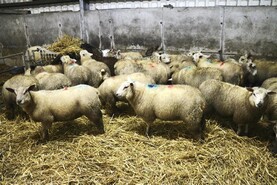Grass
The higher than normal grass growth rates recorded over the last three weeks have provided a good reprieve to farmers. However, there is a risk of these growth rates providing a false sense of security and farmers holding back from applying fertiliser.
Growth in many cases has been boosted by nitrogen in the soil that was not previously taken up by the plant and improved conditions for growth.
It is possible that growth rates could drop back significantly if nutrients are lacking.
Given that many farms have higher numbers of lambs on hand and more breeding ewes require preferential feeding, it is important to grow as much grass as possible when the opportunity is there.
The financial return of applying nitrogen now rather than waiting until closer to the deadline will also be much greater.
The optimum rate of application depends on the stocking rate and demand for grass. On highly stocked farms, the advice is 20 to 25 units/acre (25kg to 31kg/ha), while on low stocked farms a lower application of 10 to 15 units/acre (12.5kg to 18.75kg/ha) is typically recommended.
Where grass supplies are good and only a percentage of the farm is receiving fertiliser, then it is beneficial to target the swards delivering the greatest response.
There will be benefit in addressing soil phosphorus (P) and potassium deficiencies, but be careful if purchasing to ensure you have an allowance to apply P.
The best use should also be made of any remaining slurry/farmyard manure to target soils low in P and K and to replenish nutrient offtakes.
Worm counts
Many vets, advisers and farmers are reporting a spike in worm egg counts in faecal samples over the last week to 10 days. It is important to take regular samples and to dose accordingly with an appropriate product.
While the general trend is a higher egg count there is also significant variation reported, and as such there is a big benefit to taking egg counts.
Results are quick and the information could save time and money in avoiding unnecessary dosing as well as reducing the rate of anthelmintic resistance developing.
Now is also a good time of the year with a higher worm burden on pasture to carry out a faecal egg count reduction test to ensure anthelmintic resistance to the product being used is not an issue.
It is also important to quarantine lambs and implement a robust worm control programme. The general advice is to administer a new generation wormer (Startect or Zolvix) and a yellow drench.
Ram condition
The focus in many flocks is centred on finishing lambs and addressing ewe condition, with rams frequently forgotten until it is too late to achieve any worthwhile remedial attention.
Rams will lose upwards of 15% of their body weight during breeding, and as such it is important that rams are in adequate condition. The optimum is a body condition score of 3.5 to 4, with rams in a fit and not fat or thin state.
Rams should also undergo a health check well in advance of breeding to allow ample time for any shortcomings to be addressed.
Any signs of infection or lameness need to be dealt with swiftly, as any ailment that causes an elevation in a ram’s body temperature to 40°C (104°F) or higher will likely result in infertility for a period of six to seven weeks.







 This is a subscriber-only article
This is a subscriber-only article










SHARING OPTIONS: